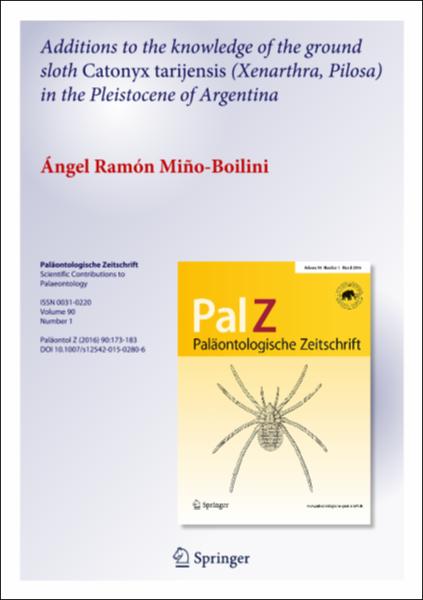Mostrar el registro sencillo del ítem
Additions to the knowledge of the ground sloth catonyx tarijensis (xenarthra, pilosa) in the pleistocene of Argentina
| dc.contributor.author | Miño Boilini, Ángel Ramón | |
| dc.date.accessioned | 2022-02-14T13:39:26Z | |
| dc.date.available | 2022-02-14T13:39:26Z | |
| dc.date.issued | 2016 | |
| dc.identifier.citation | Miño Boilini, Ángel Ramón, 2016. Additions to the knowledge of the ground sloth catonyx tarijensis (xenarthra, pilosa) in the pleistocene of Argentina. Paläontologische Zeitschrift. Nueva York: Springer, vol. 90, p. 173-183. ISSN 1867-6812. | es |
| dc.identifier.issn | 0031-0220 | es |
| dc.identifier.uri | http://repositorio.unne.edu.ar/handle/123456789/30850 | |
| dc.description.abstract | Quaternary Scelidotheriinae (Mammalia, Xenarthra, Mylodontidae) are represented by three genera: Scelidotherium Owen, Valgipes Gervais, and Catonyx Ameghino. The genus Catonyx includes three species of ground sloths: C. cuvieri (Lund), C. tarijensis (Gervais and Ameghino), and C. chiliensis (Lydekker). Catonyx tarijensis and C. chiliensis were present during the Quaternary of Argentina. The aim of this contribution is to improve the knowledge of C. tarijensis of Argentina from a morphological, systematic, and biostratigraphic point of view. The presence of C. tarijensis is recorded in the Ensenadan– Lujanian South American Land Mammal Ages (SALMAs) (Early Pleistocene–Late Pleistocene) of Buenos Aires Province, in the Lujanian SALMA (Late Pleistocene) of Corrientes Province, and in the Pleistocene of Co´rdoba and Salta Provinces. Outside Argentina, this species is recorded in the Late Pleistocene of Bolivia and Uruguay. | es |
| dc.description.abstract | Quartäre Scelidotheriinae (Mammalia, Xenarthra, Mylodontidae) sind durch drei Gattungen vertreten: Scelidotherium Owen, Valgipes Gervais und Catonyx Ameghino. Die Gattung Catonyx beinhaltet drei Arten von Faultieren: C. cuvieri (Lund), C. tarijensis (Gervais und Ameghino) und C. chiliensis (Lydekker). C. tarijensis und C. chiliensis sind aus dem Quartär Argentiniens bekannt. Das Ziel dieser Mitteilung ist es, die Kenntniss von C. tarijensis aus Argentinien in Hinsicht auf ihre Morphologie, Systematik und Biostratigraphie zu verbessern. Die Art C. tarijensis ist aus den Ensenadan - Lujanian South American Land Mammal Ages (SALMAs) (frühes bis spätes Pleistozän) der Provinz Buenos Aires, der Lujanian SALMA (spätes Pleistozän) der Provinz Corrientes und dem Pleistozän der Provinzen Córdoba und Salta bekannt. Außerhalb Argentiniens wurde diese Art bisher im Pleistozän von Bolivien und Uruguay gefunden. | es |
| dc.format | application/pdf | es |
| dc.language.iso | eng | es |
| dc.publisher | Springer | es |
| dc.relation.uri | https://doi.org/10.1007/s12542-015-0280-6 | es |
| dc.rights | restrictedAccess | es |
| dc.rights.uri | http://creativecommons.org/licenses/by-nc-nd/2.5/ar/ | es |
| dc.source | Paläontologische Zeitschrift, 2016, vol. 90, p. 173-183. | es |
| dc.subject | Mammalia | es |
| dc.subject | Scelidotheriinae | es |
| dc.subject | South American | es |
| dc.subject | Systematic | es |
| dc.subject | Quaternary | es |
| dc.subject | Südamerika | es |
| dc.subject | Systematik | es |
| dc.subject | Quartär | es |
| dc.title | Additions to the knowledge of the ground sloth catonyx tarijensis (xenarthra, pilosa) in the pleistocene of Argentina | es |
| dc.type | Artículo | es |
| unne.affiliation | Fil: Miño Boilini, Ángel Ramón. Universidad Nacional del Nordeste. Facultad de Ciencias Exactas y Naturales y Agrimensura; Argentina. | es |
| unne.affiliation | Fil: Miño Boilini, Ángel Ramón. Consejo Nacional de Investigaciones Científicas y Técnicas. Centro de Ecología Aplicada del Litoral; Argentina. | es |
| unne.journal.pais | Estados Unidos | es |
| unne.journal.ciudad | Nueva York | es |
| unne.ISSN-e | 1867-6812 | es |
Ficheros en el ítem
Este ítem aparece en la(s) siguiente(s) colección(ones)
-
Artículos de revista [674]





